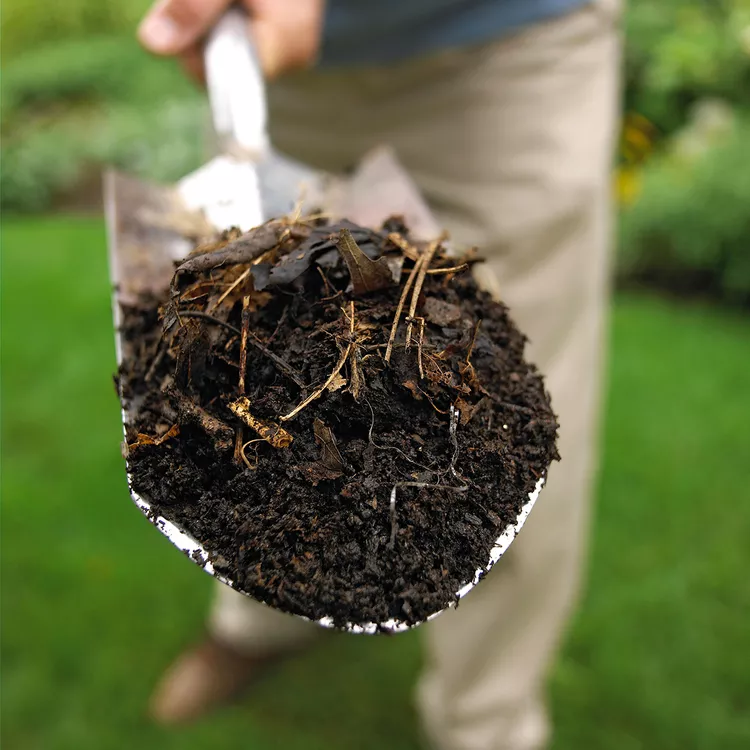Some people believe learning how to compost is too complicated, it smells bad, and it's messy. This may be true if you compost the wrong way, but learning how to compost the right way is actually quite simple. Start with a few layers of organic materials and kitchen scraps, add a dash of soil and a splash of water, and wait for your concoction to turn into humus (the best soil booster around!). This guide explains everything you need to know about how to compost successfully.
Types of Composting
Before you start learning about how to compost, it's important to know that there are a few different types of composting:
Cold composting is as simple as collecting yard waste or the organic materials in your trash (such as fruit and vegetable peels, coffee grounds and filters, and eggshells) to create a pile or fill a bin. Over the course of a year or so, the material will decompose.
Hot composting requires you to take a more active role, but the return is that it's a faster process; you'll get compost in one to three months during warm weather. Four ingredients are required for fast-cooking hot compost: nitrogen, carbon, air, and water. Together, these items feed microorganisms, which speed up the process of decay. During the growing season when garden waste is plentiful, you can mix one big batch of compost and then start a second one while the first one "cooks."
Vermicomposting is another type of composting that is made with the help of earthworms. When these worms eat your food scraps, they release castings, which are rich in nitrogen. You can't use just any old worms for this. You need redworms (also called "red wigglers"). Worms for composting can be purchased inexpensively online or at a garden supplier.
What Is Compost?
Compost is decomposed organic material that is added to soil to provide nutrients to sustain plant growth. Compost also helps to improve soil structure and water-holding capacity, and supports soil microbes that are integral to plant health.
What to Compost
Composting at home is a great way to use the things in your refrigerator that are a little past their prime, which helps reduce food waste. You can also compost certain kinds of yard waste rather than send them to the dump. Collect these materials to start off your compost pile right:
- Fruit scraps
- Vegetable scraps
- Coffee grounds
- Eggshells (though they can take a while to break down)
- Grass and plant clippings
- Dry leaves
- Finely chopped wood and bark chips
- Shredded newspaper
- Straw
- Sawdust from untreated wood
Never add meat scraps, dairy, cheese, fats/oils, pet waste, or chemically treated wood. These items either cause unpleasant odors or could contain harmful diseases or chemicals.
Keeping a container in your kitchen is an easy way to accumulate composting materials as you prep meals. If you don't want to buy one, you can make your own indoor or outdoor compost bin. For kitchen scraps that could start spoiling quickly, another option is to store them in the freezer until you are ready to add them to your larger outdoor pile.
How to Make Hot Compost
Combine Green and Brown Materials
To make your own hot-compost heap, wait until you have enough materials to make a pile at least 3 feet deep with a combination of wet (green) items and dry (brown) items. Brown materials include dried plant materials, fallen leaves, shredded tree branches, cardboard, newspaper, hay, straw, and wood shavings. These items add carbon. Green materials include kitchen scraps, coffee grounds, animal manures (not from dogs or cats), and fresh plant and grass trimmings. These items add nitrogen.
For best results, start building your compost pile by mixing three parts brown materials with one part green material. If your compost pile looks too wet and smells unpleasant, add more brown items or mix your compost with a garden fork to aerate. If you see it looks extremely brown and dry, add green items and water to make it slightly moist.
Water Your Compost Pile
Sprinkle water over the compost pile regularly so it has the consistency of a damp sponge. Don't add too much water or the microorganisms in your compost pile will become waterlogged and drown. If this happens, your pile will rot instead of compost. You can monitor the temperature of your compost pile with a compost thermometer to be sure the materials are properly decomposing. Or, simply reach into the middle of the compost pile with your hand. Your compost pile should feel warm.
Stir Your Compost Pile
During the growing season, you should provide the compost pile with oxygen by turning it once a week with a garden fork or other garden tools. The best time to turn the compost is when the center of the pile feels warm or when a thermometer reads between 130°F and 150°F. Stirring the compost pile will help it cook faster and prevents materials from becoming matted down and developing an odor. At this point, the brown and green layers have served their purpose so it's ok to stir thoroughly and intermix the two materials.
In addition to aerating regularly, chop and shred raw ingredients into smaller sizes to speed up the composting process.
Feed Your Garden with Compost
When the compost pile no longer gives off heat and becomes dry, brown, and crumbly, it's fully cooked and ready to feed to the garden. Add about 4 to 6 inches of compost to your flower beds and a thick layer to the top of pots at the beginning of each planting season.
Some gardeners make what's known as compost tea with finished compost. This involves allowing fully formed compost to "steep" in water for several days, then straining it to use as a homemade liquid fertilizer.




















